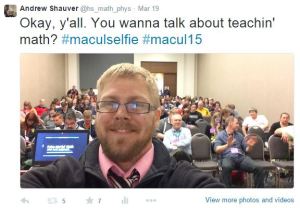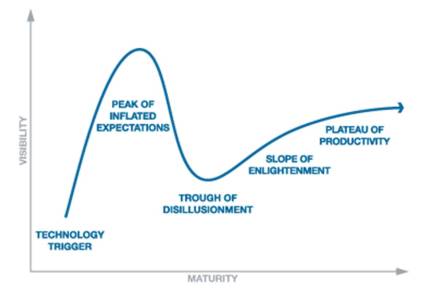You have to be careful with expecations. I heard a Deacon say in a sermon once “expecations are just opportunites to be disappointed.” And I suspect that in instances like your first ISTE Conference, it’s best to go into expecting that you’ll have no clue what to expect. Sorry… (ISTE is the International Society for Technology in Education… they have a massive conference each year.) And when you reflect on time spent there, it’s important to compare it to it’s own goals and not my expectations. The planners didn’t know my expectations. So, it’s unfair to say, “I wanted it to be this… and it’s wasn’t.” That isn’t their job.
There are people who are really high on this conference and there are folks who were very unimpressed including Adam Rozenweig (who in the comments admitted that his rather dramatic analysis, while not entirely false, was probably sold short some of the value) and Audrey Waters (who asserts that it’s time to give up on computers in education).
As with most things, my reflections are going to be somewhere in the middle and far less dramatic.
This was my first experience with ISTE of any kind. There isn’t much talk of their standards around our parts and with our own growing #EdTech group right in our backyard (MACUL), ISTE simply doesn’t make it to the classroom level very often. So, all of these impressions that were made on me were first impressions. And, as Lemony Snicket reminds us, sometimes first impressions are hasty and made in error. Other times, they are perfectly accurate. Admittedly, I simply don’t know which at this point. And what’s more, I’m not sure it’s all that important that I figure it out.
That having been said, here are my chief takeaways from my 4 days in Denver.
Takeaway #1 – ISTE is really, really big.
And I’m not entirely convinced that the growth of the educator-attendees was the primary goal. (This is Mr. Rozenweig’s chief complaint, by the way.) The signage wasn’t great, the session schedule was awkward, the BYOD/hands-on sessions had spotty networks to work on (one session I was in had bandwidth for only about half of the attendees). The keynotes were held in an auditorium that seemed to be chosen for it’s beauty… neverminding the fact that there was only enough seats for about 2/3 of the attendees. This seems indicative of a conference that invited educators for something OTHER than reflective growth. This isn’t a knock against them. I think a goal of reflective growth is awful challenging to meet with 15,000 folks in attendance. (And we’re not even talking about money… goodness. My calculations suggest that attendee registration fees alone add up to over $7 million.) So, what was the goal?
Takeaway #2 – The goal appeared to be educator-exploration.
While there were learning sessions available, many were pre-registered hands-on regarding particular technologies, sponsored sessions (like the Google room that seemed to have a Cedar-Pointe-esque line outside of it all the time) and panel-sessions. These were largely a complement to the enormous amount of exploration that was available. The BreakoutEDU bus was a low-cost (zero dollars and about half-hour of your time) exploration of a particular type of project-based learning. The poster sessions had some pretty cool stuff to show off, many of which were applications from local schools and classrooms, some with the students onsite. The playgrounds would have been cooler if they weren’t so doggone crowded, but still allowed for some exploration of things you’ve heard of but maybe haven’t seen before (Google Cardboard, for example). Then there was the expo hall…
The Expo Hall was sort of like walking through a massive (MASSIVE) #EdTech farmers market, except instead of trading cash for produce, hanging flower baskets and homemade venison jerky, your trading in e-mail addresses, business cards, and photo-ops. Just like farmer’s markets, every last person standing at a booth is a salesman. Just like a farmer’s market, many of them are offering free samples. Just like farmer’s markets, your primary value to any of those folks is your organization’s budget. Just like a farmer’s market it is very easy to get lost, over-stimulated and exhausted, or kill about 2 hours without either A) batting an eye, or B) accomplishing anything.
And just like a farmer’s market, the people who love it best are the folks who know how to get what they need in that environment. Not everyone does. And among those who do, there are those who simply do not enjoy it. Personally, I don’t mind it. And Lego let’s you play with stuff.
It just seemed like the who goal was to give educators 4 days to explore new things, ask questions, get ideas and products pitched to them by excited people and network. It was going to be difficult to build in the reflection, team brain-storming, and problem-solving in that venue.
Takeaway #3 – Despite some of the grumblers, there were good non-sponsored, educator-led sessions.
Really. There were. Michelle McCloud and Marcy Faust out of Baton Rouge, LA did a great talk on transforming unused media center space into a “Learning Commons” by approaching the science department and offering to lend a hand. Super down-to-earth. The current status is quite excited and productive, but the process to getting there was the topic of the session. It was in this session that I relearned a really valuable lesson: Awesome things become awesome through careful and reflective step-by-step planning. Thinking of the details and being clear about the goals. Spontaneous awesome is either pure luck or not nearly as spontaneous as it seems.
Ben Wilkoff (@bhwilkoff), Jessica Raleigh (@tyrnad) and Brandon Petersen (@den_petersen) from Denver had a nice talk about ways to support the use of video in the classroom as a reflective tool for students, teachers, and coaches. Format was excellent and bringing three people helped to make the hands-on nature efficient.
James Kapptie out of Wyoming did something that no other session I had ever been in (at ANY conference… ever) did. He led us, like a band of sight-seers in a new city, through 16th Street in Downtown Denver and used that to model his learning targets which were primarily that we have to get students up and moving and the tech (in this case, augmented reality) needs to support that.
Finally, I rather enjoyed the candid panel discussion regarding improving teacher PD by Julie Keane, Liz Radzicki, and Margaret Conway out of Chicago. I’m on a team right now that kicks off a different plan with similar goals this fall, so I was very interested to hear how they did, what worked, what didn’t and they were very candid and took many questions from the group.
In the end, ISTE 2016 probably did for me what it was supposed to. I networked with some educators, I learned about some new stuff (products, services, teacher moves, etc.) and took really good notes so that if I forget anything, I’ll have something look back on. I look forward to moving forward to seeing how these experiences show their value in the weeks, and months ahead.









